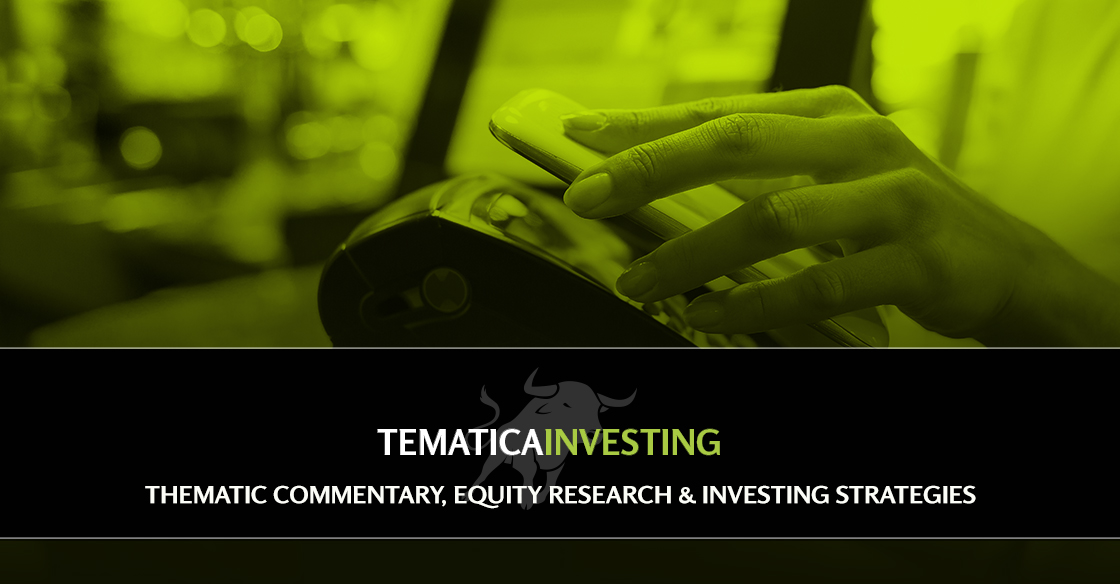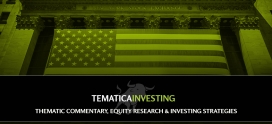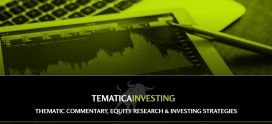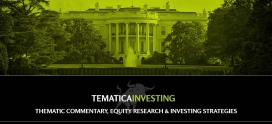Could we have a new Investment Theme to add to the mix?
|
The stock market continued to move higher over the last week, as oil sold off this week and we inch closer to what seems like an inevitable interest rate hike. As we wrote in this week’s Monday Morning Kickoff, the stock market increasingly looks to be ahead of itself and now we are starting to see the conversation regarding 2017 earnings expectations shift to one with an upward bias – analyst code for thinking expectations need to be raised – despite the fact that earnings for the S&P 500 have been flat for the last few years. Let’s remember, those 2017 expectations already call for an 11 percent increase and odds are the earliest we would see any Trump Bump to the economy would be in the second half of 2017.

Yep, it’s looking like the froth is getting a little thick, which is why we’re holding off from adding any new positions to the Tematica Select Investment List. But rest assured, we still have a packed issue this week as we provide updates on many of our positions — most of which have enjoyed the recent market rally — as well as a look inside at an internal debate we’ve been having as we discuss adding a new theme to the line up of our investing themes.
Updates, Updates, Updates
We recently added Facebook (FB) as our latest Connected Society investment theme pick as well as McCormick & Co. (MKC), which announced a nice increase in its annual dividend – just like we expected. While both have seen slight short-term setbacks, such retreats we see as an additional opportunity to get in on them if you haven’t already. We continue to rate both as a Buy.
We’ve also started to see our Amazon (AMZN) and Alphabet (GOOGL) shares rebound – as we said recently, the thematic drivers remain very favorable for those two positions as well as Facebook and we’re going to be patient with all three. The same goes with Dycom Industries (DY) as network capacity issues are only going to get worse as streaming continues to overtake broadcast TV viewing as part of our Connected Society investing theme.
With a deal between CBS Corp. (CBS) and AT&T (T) that would bring the broadcaster’s content to AT&T’s new DIRECTV Now service — which by the way Tematica CIO Chris Versace is enjoying immensely — we continue to be bullish on AT&T shares. Our larger concern remains the uncertainty over AT&T’s acquisition of Time Warner (TWX), which through our thematic lens would transform AT&T into a Connected Society and a Content is King player. President-elect Trump was negative on the proposed merger during the campaign, calling it “an example of the power structure I am fighting.” Of course, we’ve already seen a difference between candidate Trump and President-elect Trump. Capitol Hill hearings on the proposed merger begin today, so we’ll continue to watch all of these developments as we collect on that enviable dividend stream given AT&T’s dividend yield of 5.0 percent.
Our Disney (DIS) positions have continued to rally and are up meaningfully from their summer lows. With the next Star Wars (Rouge One – A Star Wars Story) installment set to drop at the end of next week — yes, the Tematica team will be there with a large tub of popcorn in hand! — it once again looks to be a very Star Wars Christmas toy season.

Finally, the industry chatter over Apple (AAPL) adopting organic light emitting diode (OLEDs) technology across its iPhones and iPads continues, but come CES 2017 — the big consumer electronic trade show — Sony (SNE) will be introducing its first OLEDs TV. As competitors like LG, Samsung and others look to bring their OLEDs TVs to market, industry capacity will need to expand. Good news for Universal Display’s (OLED) chemical and licensing business, that also happens to be good for our shares of this Disruptive Technology company.
While we know you can find the finer points for those companies in the Select List table that can be found on page 7, each of those companies remains a Buy at current levels.
What does it take for an investing theme
to make the thematic cut?
One of the dangers that we’ve seen others make when attempting to look at the world thematically is they confuse a trend or a “flash in the pan” for a sustainable shift that forces companies to respond. Examples include exchange-traded funds (ETFs) that invest solely in smartphones, drones or battery technologies. To begin with, there aren’t enough publicly traded companies to fill out such a strategy, but the reality is those are beneficiaries of the thematic shift, not the shift itself. You would think for all the smart people running around Wall Street they would see this, but they don’t.
 We’ve talked with several firms that are interested in incorporating Environmental, Social and Governance — or ESG — factors as part of their investment strategy. Some even have expressed the interest in developing an ETF based on an ESG strategy alone. While we can certainly understand the desire among socially conscious investors to ferret out companies that have adopted that strategy, we do not see it as a sustainable differentiator given that more and more companies are complying.
We’ve talked with several firms that are interested in incorporating Environmental, Social and Governance — or ESG — factors as part of their investment strategy. Some even have expressed the interest in developing an ETF based on an ESG strategy alone. While we can certainly understand the desire among socially conscious investors to ferret out companies that have adopted that strategy, we do not see it as a sustainable differentiator given that more and more companies are complying.
In other words, if everyone is doing it, it’s not a differentiating theme. Moreover, compliance to an ESG movement does not alter the long-term demand dynamics for a category, even if certain businesses enjoy a short-term surge in revenues.
For example, does the fact that Alphabet (GOOGL) targets using 100 percent renewable energy by 2018 alter the playing field or improve the competitive advantage of its core search and advertising business? Does it do either of those for YouTube?
The result is a trend that is likely to be medium-lived, if not short lived. Said another way, it looks to us to be more like an investing fad, rather than a pronounced thematic driver shift that has legs.
As you know we are constantly turning over data points, looking for confirmation for our thematic lens as well as early warning flags that a tailwind might be turning into a headwind. As we collect those data points, we mine the observations that bubble up to our frontal lobes and at times ask if perhaps we have a new investing theme on our hands. Sometimes the answer is yes, but more often than not, it’s a no.
Now you’re in for a treat! Some behind the scenes action if you will on how we think about new themes and why one may not make the cut…
On-Demand economy enough to become a new investing theme?
Recently we received a question from a subscriber asking if the number of “on-demand” services and business emerging were enough to substantiate the addition of a new investment theme to go along with the other 17 themes we currently track.

By on-demand, we’re talking about those services where you can rent a car (Lyft or Uber) or apartment (AirBnB) with the click of a button for only the time you need it. Or the many services that will deliver all the ingredients you need to prepare a gourmet meal in your own kitchen. We’re talking about things like Blue Apron or Hellofresh.
It was an interesting question because frankly, it’s something we have been debating at Tematica Research for quite some time. Ultimately, we came to the conclusion that the real driver behind the on-demand economy is businesses stepping into fill the void created by a combination of multiple themes, rather than a new theme in of itself. Here’s what we mean . . .
Take the meal kit delivery services like Blue Apron.
What’s driving the popularity of this service? We would argue that it’s not the fact that people like seeing their UPS driver more (although we do know many women that seem to have a thing for the brown shorts and socks). Rather it is the result of underlying movement towards more healthy and natural foods that omit chemicals and preservatives — something we have discussed as the driver behind the Foods with Integrity theme.
The key barrier to this movement towards healthier cooking that is Foods with Integrity is the amount of work it takes to cook such foods — the shopping, the measuring, the cutting and preparation time, not to mention the cost. In steps Blue Apron and consumers flock to it. So we see the meal delivery services as an enabler of Foods with Integrity rather than a theme itself.
There is also a clear element of the Connected Society investment theme behind these services, given how customers order the ingredients to prepare the meals – via an app or online – as well as Cashless Consumption given the method of payment does not involve cash or check. So we are clear, the primary theme at play here is Foods with Integrity, but we do like the added oomph from those other themes.
Let’s look at Uber, the on-demand private taxi service.
We’re big users of the service, particularly when we are traveling, and we love the ease of use. We also like the payment experience — or the lack of an experience. We’re talking about having the ride fee automatically charged to our account. No cash, no credit card swiping or inserting, no awkward “how much do I tip?” moments. It’s our Cashless Consumption theme in all of its glory.
The big users of the Uber and Lyft services and the ones driving the firms’ valuations to stratospheric levels are the Millenials who are opting to just “Uber “ around town — it’s become a verb — or use a car-sharing service like a ZipCar (ZIP) or the like.
Sure, the Millenials have the reputation of being a more thrifty, frugal group compared to previous generations. But we have to wonder is it them being thrifty or just coming to grips with reality? With crushing costs of college and student loans, as well as stagnant wage growth and many young workers having to cobble together part-time and contractor jobs rather than a full-time salaried position, what choice do they have? So why buy a car and pay for it to sit there 75% of the time when you can just pay for it when you need it? We call that the Cash-strapped Consumer theme and many businesses have stepped into this void as part of what has become known as the “sharing economy.”
Finally, what is the underlying function of all these on-demand services?
As we mentioned earlier, it’s the ability to connect and customize the services through a smartphone app or desktop website, or from our thematic perspective, the Connected Society.
Now let’s tackle the headwind, which involves those companies that are not able to capitalize on the thematic tailwind. In many respects, it reminds us of how Dollar Shave Club beat Gillette, owned by Proctor & Gamble (PG), and Schlick, owned by Edgewell Personal Care (EPC), by addressing the pain point of the ever-increasing cost of razor blades with online shopping.
Boom! Cash-strapped Consumer meets Connected Society. While Gillette has flirted with its own online shave club, the price of its razor are still significantly higher and as far as we’ve been able to tell Schick has no such offering. As Dollar Shave Club grew and expanded its product set past razors to other personal care products, Unilever (UL) stepped in and snapped it up for $1 billion.
Going back to the beginning and the impact of the food delivery services like Blue Apron — are we likely to see food companies build their own online shopping network? Most likely not, but they are likely to partner with online grocery ordering from Kroger (KR) and other such food retailers. That still doesn’t address the shift toward healthy, prepared meals and it’s requiring a major rethink among Tyson Foods (TF), Campbell Soup (CPB), The Hershey Company (HSY), General Mills (GIS) and many others. Fortunately, we’ve seen thematic signals for many of those companies doing just that.
The key takeaway from all of this is a thematic tailwind can be thought of as a market shift that shapes and impacts consumer behavior, forcing companies to make fundamental changes to their businesses to succeed. If they don’t, or for some reason can’t, odds are their business will suffer as they fly straight into an oncoming headwind.
As thematic investors, we want to own those companies with a thematic tailwind at their back — or maybe even two or three! — and avoid those that either seem oblivious to the headwind or won’t be able to reposition themselves like a sailor looking to tac across a body of water to where the wind is blowing.
Of course, when it comes to these “On-Demand Economy” darlings — Uber, Dollar Shave Club, Airbnb —few if any of them have been publically traded, which frustrates us so, since most of them are tapping into more than one thematic tailwind at once. If and when they do turn to the public markets for some added capital and we get a look into the economics of these business models, then we’ll also get to see the key performance metrics and financials behind these businesses. One can only hope . . .
|





